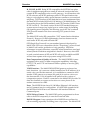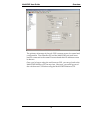
Overview MultiVOIP User Guide
18
H. 323, SIP, & SPP. Being H.323 compatible, the MVP3010 can place
calls to telephone equipment at remote IP network locations that also
contain H.323 compatible voice-over-IP gateways. It will interface with
H.323 software and H.323 gatekeeper units. H.323 specifications also
bring to voip telephony many special features common to conventional
telephony. H.323 features of this kind that have been implemented into
the MultiVOIP include Call Hold, Call Waiting, Call Identification, Call
Forwarding (from the H.450 standard), and Call Transfer (H.450.2 from
H.323 Version 2). The fourth version of the H.323 standard improves
system resource usage (esp. logical port or socket usage) by handling
call signaling more compactly and allowing use of the low-overhead
UDP protocol instead of the error-correcting TCP protocol where
possible.
The MultiVOIP is also SIP-compatible. (“SIP” means Session Initiation
Protocol.) However, H.450 Supplementary Services features can be
used under H.323 only and not under SIP.
SPP (Single-Port Protocol) is a non-standard protocol developed by
Multi-Tech. SPP is not compatible with the “Proprietary” protocol used
in Multi-Tech’s earlier generation of voip gateways. SPP offers
advantages in certain situations, especially when firewalls are used and
when dynamic IP address assignment is needed. However, when SPP
is used, certain features of SIP and H.323 will not be available and SPP
will not inter-operate with voip systems using H.323 or SIP.
Data Compression & Quality of Service. The MultiVOIP3010 comes
equipped with a variety of data compression capabilities, including
G.723, G.729, and G.711 and features DiffServ quality-of-service (QoS)
capabilities.
VOIP Functions. The MultiVOIP MVP3010 gateway performs four
basic functions: (a) it converts a dialed number into an IP address, (b) it
sends voice over the data network, (c) it establishes a connection with
another VOIP gateway at a remote site, and (d) it receives voice over
the data network. Voice is handled as IP packets with a variety of
compression options. Each E1 connection to the MultiVOIP provides 30
time-slot channels to connect to the telco or to serve phone or fax
stations connected to a PBX.
Ports. The MVP3010 also has a 10/100 Mbps Ethernet LAN interface,
and a Command port for configuration. An MVP3010 upgraded with
the MVP30-60 kit will have two Ethernet LAN interfaces and two
Command ports.
PSTN Failover Feature. The MultiVOIP can be programmed to divert
calls to the PSTN temporarily in case the IP network fails.
RADIUS Support. Inter-operation with a RADIUS server allows for
call accounting (especially for billing) on a voip system. The MultiVOIP


















